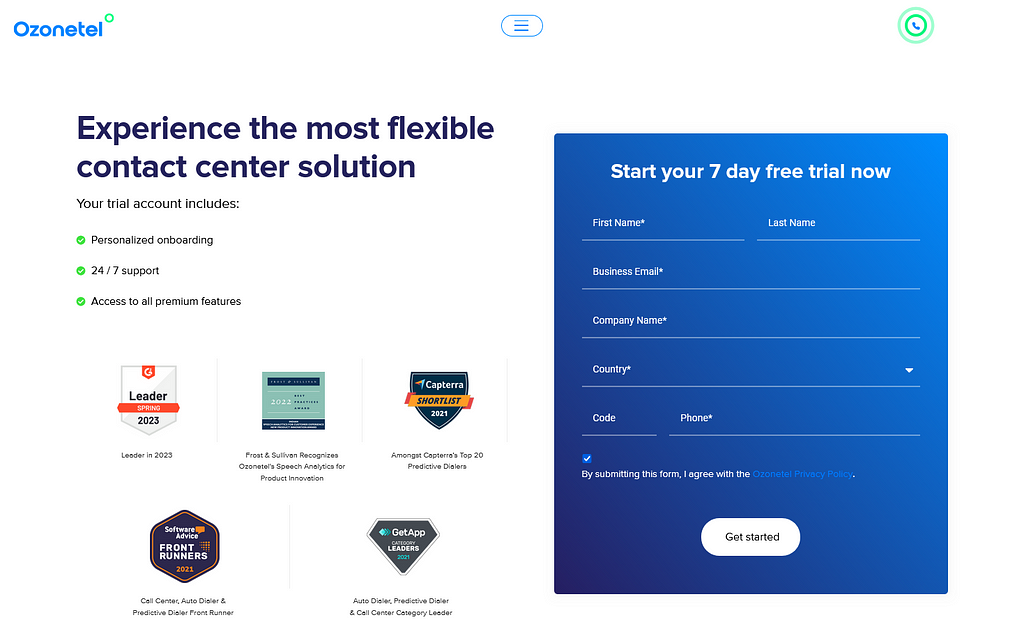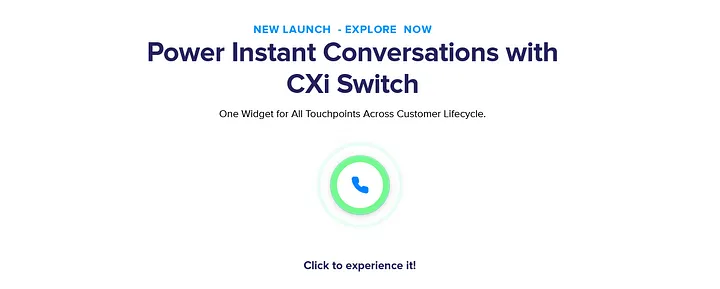- Resources
- What is A Cloud Telephony Solution? How Does It Work
What is A Cloud Telephony Solution? How Does It Work

Cloud telephony – it’s a complicated and kind of funny-sounding term, but for businesses today, it’s an essential technology that can make a huge difference in terms of how they communicate. Just look at recent data and you’ll quickly see why. In this age of hyperconnectivity, people are using multiple devices, from laptops to smartphones, to communicate with others, and they expect businesses to be available on every one of those channels.
There’s no better way to consolidate them all than by leveraging the cloud.
Cloud telephony systems enable businesses to seamlessly integrate all their different communication systems, including VoIP phones, SIP trunking, and cloud-based PBX solutions in one place.
This technology is becoming less of a way to stay ahead and more of a requirement for any organization that wants to remain afloat as call center operations become increasingly digital. Reports suggest that the cloud telephony market will grow by a CAGR of 9.5 percent between 2022 and 2032 to reach a total value of US $51.5 Billion. Can you afford to miss out?
Keep reading to learn more about cloud telephony, the technology that powers it, and how it can benefit your business’ customer service and sales outreach efforts.
In this article, we will explore:
What Is Cloud Telephony?
Cloud telephony is defined as the process of making phone calls via the Internet instead of traditional landlines or mobile networks. It allows businesses to use existing hardware and software technologies like VoIP (Voice over Internet Protocol) to enable voice communication between two parties over the Internet. This type of technology has advantages for both small and large companies, including improved customer service, cost savings on long-distance bills, and features like voicemail and call forwarding.
Cloud telephony can be particularly helpful to businesses with multiple locations or employees who work remotely. VoIP technology gives agents the ability to make calls from anywhere in the world so long as they have an internet connection. Perhaps even more impressively, that accessibility doesn’t come at the cost of security.
How Cloud Telephony Works?
Cloud telephony services can be started on a traditional phone, mobile or a computer system i.e. desktop, laptop or tablet. It works via two networks:
PSTN – Many countries do not allow the mixing of IP and PSTN calls like India and Middle East countries. These countries use PSTN-based cloud Telephony solution
IP – Cloud telephony services are delivered via the internet. Some countries such as the United States have internet-linked calling or are VoIP enabled for providing Cloud Telephony services.
PSTN-Based Cloud Telephony To understand better, let’s look at a traditional solution and compare it with the cloud telephony architecture Traditional PBX Solution. In a conventional setup, to start any enterprise telephony solution like a PBX or small call center, we need a dedicated PRI—a PRI server and a conventional call center solution.

Now, look at the above image of a “cloud telephony architecture”. Here all the devices like PRI Line, application server, etc. are hosted or reside at the service provider’s premises and all the applications/devices are maintained by the service provider.
Features of Cloud Telephony
Enticed by what the definition of cloud telephony suggests? You’ll find this list of popular features even more impressive:
Auto Dialing
Auto dialing enables contact centers to automatically place calls without manual labor. It can be used in customer service, sales, and marketing.
Call Analytics
In-depth call analytics provide an overview of customer interactions. Call logs display dates, times, and types of calls made on the system. This can be especially useful for tracking marketing efforts or understanding how customers are reaching out to contact your business.
Interactive Voice Response (IVR)
If you don’t have enough agents to answer all your incoming calls, IVR picks up the slack. It allows callers to choose from a range of options and direct themselves towards specific departments or services without having to speak with an agent.
Call Recording
In customer service, quality control is everything. Managers need the ability to keep tabs on their team members’ conversations so that potential performance issues can be addressed head-on. Cloud telephony enables them to do just that with automatic call recording capabilities.
Call Forwarding
Call forwarding allows users to redirect incoming calls from one phone line to another number. This is especially helpful when needing a single point of contact or if an employee needs access to someone’s work phone while not in the office.
SMS Capabilities
It’s the twenty-first century, so why wouldn’t your business want to use text messages? With cloud telephony, you can send out bulk SMSs to get in touch with potential customers or communicate with established ones hassle-free.
Why Do Businesses Use Cloud Telephony?
In today’s day and age, call centers face an insurmountable amount of customer inquiries. These calls can range from simple questions such as “What is your company’s return policy?” to complex ones like “How do I set up this feature on my device?” The challenge for call centers is managing them all without losing efficiency.
Enter cloud telephony. With this technology, businesses are able to route incoming customer calls much more efficiently and accurately than they would the manual way. Customers get connected to the right people faster – improving their overall experience to ultimately translate into higher overall levels of satisfaction.
Cloud telephony is more than just a way to quickly connect customers with the right people, though; it also provides powerful analytics and insights that can help businesses measure their performance, track customer interactions, and improve their customer service. This data isn’t a luxury, but rather crucial to understanding customer needs and building better call flow strategies amidst ever-growing demand.
Take a look at the list below for more compelling reasons to consider cloud telephony over traditional systems.
Simple and Cost-Effective Set-Up Process
Cloud platforms are designed to be set up quickly and easily, with minimal effort for IT teams. This reduces expenses associated with deploying complex hardware and software solutions that require significant resources to manage.
Helpful Integrations
The best cloud telephony solutions are designed to integrate with Customer Relationship Management (CRM) platforms such as Salesforce, Hubspot, Zoho, Zendesk, Freshdesk, and Slack. Connecting these tools has the potential to boost productivity, streamline workflows, and enhance customers’ experience even further.
Omnichannel Outreach
It’s important to recognize that cloud telephony isn’t limited to phone calls. Other digital channels like SMS, WhatsApp, and Twitter/X can be quickly added to your call center environment with the right solution.
Reports and Insights: Cloud telephony software comes equipped to measure and report on a variety of pivotal call center metrics, from calls made and held to average call duration and time-to-resolution.
Easy to Scale
Need to increase the number of customer service agents on your team or add more lines to manage call center traffic? Cloud telephony solutions are characterized by scalability, meaning that you can add and remove lines quickly and easily.
How Does Cloud Telephony Work In India?
Cloud telephony solutions are extremely popular in India given the country’s strong and prosperous call center industry. Managers implement software intending to maximize each of their agents’ productivity and keep their customer service top-notch.
When your entire phone system gets migrated to the cloud, customers won’t be calling your office lines but a published cloud telephony number. There can be three scenarios when there is an incoming call from a published phone number – mobile or toll-free:
Scenario 1: Call forwarding to a PRI (Primary Rate Interface) line in the data center
Scenario 2: Call forwarding to a PRI number from the cloud
Scenario 3: Call forwarding to cloud telephony servers (capable of call recording, IVR, reporting, API, and other functionalities) with multiple PRI lines
Incoming Call Process

When customers call the published number, the cloud telephony system efficiently forwards the call to PRI lines, employing intelligent routing based on predefined logic. This ensures seamless connectivity, directing callers to available agents or an IVR system, optimizing the customer experience.
Outgoing Call Process

Initiating from the CRM software, agents dial numbers, triggering API signals to the cloud telephony servers. The server promptly calls the agent, then dynamically dials the customer. This orchestrated flow ensures a smooth outbound call experience, enhancing efficiency in customer interactions.
Cloud Telephony vs VoIP
Although the terms are sometimes used interchangeably, it’s important to recognize that cloud telephony and VoIP are two different technologies. Cloud telephony is more like a hands-on approach to managing calls – using real-time data for dynamic routing and providing organizations with the ability to adjust their services quickly. VoIP, on the other hand, is a digital technology that allows voice and multimedia content to be transmitted over the Internet.
The best way we can explain it is with this statement:
All cloud telephony systems use some degree of VoIP technology to work. Not all VoIP systems, however, are cloud-based.
Here’s is an expanded rundown of the differences between the two.
Functionality
Cloud telephony enables businesses to make and receive calls using the cloud, while VoIP allows businesses to make calls over the Internet. Both technologies offer a range of features such as call forwarding, voicemail, and automatic call distribution (ACD).
Cost
Cloud telephony is generally more cost-effective than VoIP because it eliminates the need for on-site hardware and infrastructure. This means that businesses can save money on monthly fees and installation costs, as well as reduce their overall maintenance costs. VoIP, on the other hand, typically requires additional hardware or software to work.
Features
Cloud telephony offers a range of features such as call forwarding, virtual receptionist, automated attendant, and call recording. VoIP has many similar capabilities but often lacks the more advanced features that cloud telephony offers.
Flexibility
Cloud-based technology makes it easier to scale up or down depending on business requirements, providing businesses with greater flexibility than VoIP.
Hardware/Infrastructure
Cloud Telephony eliminates the need for on-site hardware, reducing physical infrastructure requirements. VoIP may necessitate on-site hardware or software installations, potentially adding to the complexity and cost.
Installation
Cloud Telephony saves on installation costs, as it operates predominantly in a cloud-based environment. VoIP may involve additional installation costs, particularly for on-premise hardware or software setups.
Maintenance
Cloud Telephony reduces overall maintenance costs, as the service provider manages and updates the infrastructure. VoIP may require higher maintenance costs associated with maintaining on-site equipment and software components.
Why Businesses Choose Cloud Telephony?
Businesses opt for Cloud Telephony for a host of reasons. Its versatile features cater to diverse needs, vastly improving communication between customers and businesses, making it a preferred choice across industries. Let’s take a closer look.
Cost Reduction: Implementing cloud telephony brings tangible savings to businesses by reducing IT costs. Whether in offices, call centers, or manufacturing plants, organizations across diverse industries experience significant efficiency gains.
Enhanced Call Center Operations: Call center managers leverage cloud telephony to intelligently route calls to the most qualified agents. This strategic approach minimizes wait times, elevates customer satisfaction, and proves especially valuable in high-stakes customer service scenarios.
Specialized Call Routing: In industries like insurance, where specific knowledge is crucial, cloud telephony excels. It enables the routing of calls based on coverage types, ensuring policyholders connect with agents well-versed in addressing their unique needs.
Automated Voice Response: Cloud telephony’s automated voice response systems streamline customer service. They offer swift responses to frequently asked questions, reducing the reliance on 24/7 call agent staffing. This automation proves invaluable for cost savings without compromising customer service.
Efficient Technical Support: Companies benefit from cloud telephony when providing advanced technical support. It ensures that calls requiring specialized assistance are directed to the most capable agents, optimizing issue resolution and customer satisfaction.
Industry-Agnostic Efficiency: The efficiency gains from cloud telephony extend seamlessly across industries, from traditional office settings to dynamic manufacturing environments. Its versatility makes it a valuable asset for businesses of all types and sizes.
Operational Streamlining: Cloud telephony not only improves customer-facing operations but also streamlines internal processes. Its adaptable features empower organizations to customize communication workflows, fostering operational efficiency and agility.
How Ozonetel Cloud Telephony Solution Helps Businesses
Let’s understand how Ozonetel’s cloud telephony works through these five use cases.
Case Study 1
Big Basket had a clear goal: answering every customer call with a human voice in seconds and making the most of the data collected during these calls. Plus, they wanted to give a little extra to their regular, loyal customers. Here’s how Ozonetel’s helped the e-grocery firm reduce its wait times to less than 10 seconds. Read More
Case Study 2
One of India’s top stockbroking firms aimed for great customer service using Ozonetel’s CCaaS platform. They could handle a whopping 40,000+ calls daily, ensuring smooth service even during high call times. With up to 1340 calls at once, they kept things running, leading to happier customers and higher CSAT scores. Read More
Case Study 3
To make life easier for customers seeking insurance claims, Acko, an Insuretech company, used our CX platform. They created a smart self-service tool that quickly understood customer needs. This genius move led to claims getting sorted 50% faster and customers being much happier in the end. Read More
Case Study 4
A growing healthtech company wanted to be there for every patient. With Ozonetel’s CX Platform, patients could book appointments and get medical advice through calls or WhatsApp. Every time they reached out, they spoke to the same healthcare advisor, building trust. This simple change led to a big 36% increase in customer satisfaction. Read More
Case Study 5
When COVID-19 brought the world to a halt, Dr. Lal PathLabs faced a tough challenge in conducting testing and supporting patients. The pandemic, with its lockdowns and a surge in incident-driven calls, made these tasks extremely complex. In response, the Dr. Lal PathLabs team opted to automate numerous queries to efficiently handle the increased demand and better serve a vast number of customers. Here’s how Ozonetel helped the diagnostic firm. Read More
How to Choose a Cloud Telephony Service Provider
Is Cloud Telephony the right fit for your business? Before diving in, consider these key factors:
Platform Capabilities
Define Your Needs: Brainstorm with your team to identify specific requirements. Are you managing sales/support calls or sending customer updates?
Feature Evaluation: Assess if the platform supports essential features like call routing, CRM integration, call recordings, and bulk SMS options.
Cost Analysis: Clarify costs associated with call rates and additional services to align with your budget.
Platform Reliability
Uptime Assurance: Check the provider’s uptime range. Seek confirmation from their support team for transparency.
Trial Runs
Hands-On Experience: Request a trial run to test functionalities before committing.
Personalized Demo: Opt for a 1:1 demo with the support team for a more personalized exploration.
Seamless Transitions
Integration Ease: Evaluate how easily the cloud telephony system integrates with your existing apps, helpdesk, or CRM.
Installation and Maintenance: Assess whether specialized assistance is needed for setup and ongoing maintenance.
Knowledge Base: Explore the availability and utility of a knowledge base for user understanding.
Data Security
Certifications and Measures: Prioritize platforms with security certifications, robust audit logs, monitoring systems, data backup, recovery plans, and encryption protocols.
Pricing Transparency
Hidden Costs: Inquire about any potential hidden charges. Understand the structure of software rental and call rates.
Cost-Benefit Analysis: Ensure that the pricing aligns with your usage patterns and business needs.
Support and Training
Customer Support Quality: Assess the responsiveness and effectiveness of customer support.
Training Resources: Evaluate the availability of training resources to empower your team in effectively utilizing the telephony system.
By systematically considering these factors, you can make an informed decision when selecting a Cloud Telephony Service Provider tailored to your business needs.
In Conclusion
In summary, the future looks bright for cloud telephony as it has transformed the way businesses communicate. Its versatility, cost-effectiveness, and feature-rich nature make it a powerful solution for diverse industries. Want to set up a cloud telephony solution to ease your customer communications? Contact us for a free demo.
Ready to take control of your call transfer
experience for better CX outcomes?
Frequently Asked Questions
A cloud phone system is a Voice over IP (VoIP) based business telephone platform that operates through the internet, providing businesses with flexibility and scalability without the need for traditional on-site infrastructure.
Ozonetel is a leading example of cloud telephony, offering robust and scalable solutions for businesses seeking efficient communication services.
While both leverage internet-based communication, cloud telephony enables businesses to conduct phone calls over the internet, while VoIP is a technology that allows businesses to make phone calls over the internet.
Prashanth Kancherla
Chief Operating Officer, Ozonetel Communications
Over the past decade, Prashanth has worked with 3000+ customer experience and contact center leaders...
Chief Operating Officer, Ozonetel Communications
Over the past decade, Prashanth has worked with 3000+ customer experience and contact center leaders to comprehensively understand the need for effective and efficient customer communications at every step of their journey with a brand. Deeply embedded in today’s CCaaS ecosystem, he has been instrumental in Ozonetel's growth and contributed in various roles including product management, sales, and solution architecture.







